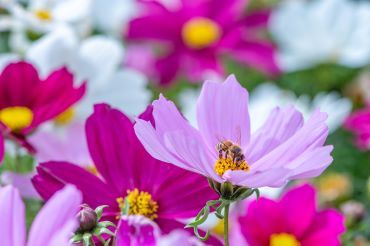
Plants are a wonderful way to add beauty and interest to your front and back garden. They bring a pop of colour and will attract such things as butterflies and bees. But what if you’re new to bedding plants and aren’t sure where to begin? Here are some basic tips on how to care for bedding plants, focusing on the most popular varieties homeowners tend to buy.
What are Good Bedding Plants – What to Pick
Before you start worrying about feeding and watering your plants, choose the bedding plants that are going to look best in your garden. Bedding plants tend to be low-maintenance and come in different colours and varieties. A few to consider include:
- Pansies
- Geraniums
- Petunias
- Cosmos
- Primroses
- Violas
You’ll want to pick them based on how much/how little sunlight the garden bed will receive in the day (part-shade or full sun). If your plants will enjoy sunshine all day, be sure to choose a hardy bedding plant like petunias, geraniums, or pansies.
Understand How Much and When to Water Your Bedding Plants
Now that you’ve got your plants in the ground you want them to flourish and look as healthy as possible. Water is one of the essentials they need, but just how much water should you give them and when?
A good rule of thumb is that your bedding plants in pots and baskets will need watering daily. This is even more important during the hot summer months. If the plants get a lot of direct sunlight, they may even need to be watered twice a day during dry spells. Alongside proper watering, choosing from the top ten summer bedding plants, like petunias, begonias, and marigolds, can ensure a vibrant and resilient display.
As for ground/garden beds, watering should be based on how dry the soil feels to the touch. Chances are the plants will still require daily watering, especially if you’re going through a hot and/or dry spell. Even after rain, plants such as geraniums have a lot of leaves and foliage that can impede the water from reaching the soil. This is why rainfall may not be enough.
Be mindful of over-watering too, as you don't want to drown the plants. Common signs of overwatering include yellowing leaves, slow growth, stunted growth, and leaves falling off faster than normal.
Plants Need Food Too
While water is important to plants, you will also need to feed them. Proper plant nutrition leads to bigger, brighter, and more blooms. If you've added compost to your basket or container, don't assume this is enough nutrition, as it will have very limited benefits. Generally speaking, all nutrition from compost is lost after four to six weeks.
There are all kinds of different fertilisers you can look at, but a key ingredient is potassium. This encourages blooms. Tomato feed is known to have high levels of potassium and is good for bedding plants. Liquid fertiliser is mixed with water, but it is also available as granules. Granules will be easier to deal with since there is no mixing required, and you can find slow-release formulations that your plants can draw from as needed.
During the growing season, you'll need to feed your plants every two to four weeks.
These simple tips will help to ensure your bedding plants look beautiful and healthy throughout the growing season.




